Tyler Glasnow has looked like a mess for a while now. He’s had the big stuff, but he’s also always walked too many hitters for it to matter. On Sunday, Glasnow went up against a Boston Red Sox lineup which, despite the presence of Mookie Betts, J.D. Martinez, Andrew Benintendi, and Xander Bogaerts, has overall been quite underwhelming this year. Glasnow outdueled Chris Sale, and while Sale’s continual struggles and lowered velocity predominated much of the conversation, Glasnow was quietly dominant.
To state the obvious, Glasnow has really benefited from his move to the Tampa Bay Rays, and after spending an offseason with them, he finally looks like a legitimate starting pitcher. His Sunday start is notable to me: It’s the most unique start of his career because of the manner in which he pitched. I’ll get to that, but first, let me gush over how Glasnow has changed.
Glasnow, in 2018 and 2019:
| K-BB% | xwOBA | ERA | xFIP | SIERA | |
| Pirates ’18 | 15.6% | 0.287 | 4.34 | 3.47 | 3.64 |
| Rays ’18 | 20.2% | 0.300 | 3.28 | 3.41 | 3.52 |
| Rays ’19 | 22.6% | 0.253 | 1.75 | 3.19 | 3.37 |
Moving from the Pittsburgh Pirates to the Tampa Bay Rays is the best thing that could have happened to him — that’s clear. But he’s also improved vastly just in the time between his Rays stint in 2018 and this season, not just since departing from the Pirates.
To date, Glasnow has the 15th lowest BB% in the league — notably, below Miles Mikolas, Yusei Kikuchi, and Kyle Hendricks. Of pitchers with 20 or more innings pitched this year, that’s the single most improved BB% in baseball since last year. If you ask Glasnow himself, even he won’t claim to be able to hit his spots at will, so for most it’s a little startling to find his name in such an auspicious spot on a walks leaderboard.
There are several things changes in the works, but one stands out: He’s throwing in the zone more. Out of 140 pitchers in 2018, Glasnow ranked 127th in strike rate. This year, Glasnow has jumped to 15th out of 132. Glasnow has moved from ninth percentile to the 88th percentile in strike rate. That is… insane. He’s gone from someone who couldn’t throw strikes to one of the best strike-throwers in the league.
Some reasons are more obvious than others:
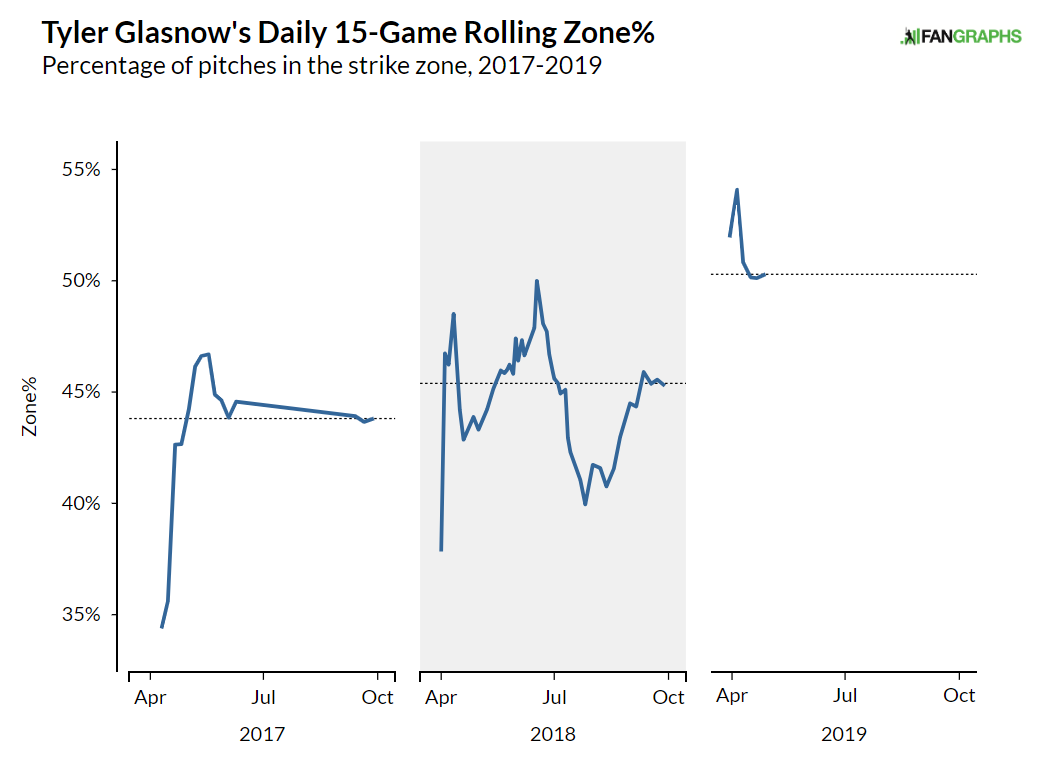
Even before his time with the Rays, you can see that Glasnow toyed with throwing in the zone. This isn’t unprecedented. But also, he generally returns to throwing in the zone a lot less. He hasn’t yet, and it sure sounds like he isn’t planning to. He’s in the zone even more than his peaks in 2018, and what also matters is where he’s throwing in the zone.
Glasnow’s vertical pitch location, by year:
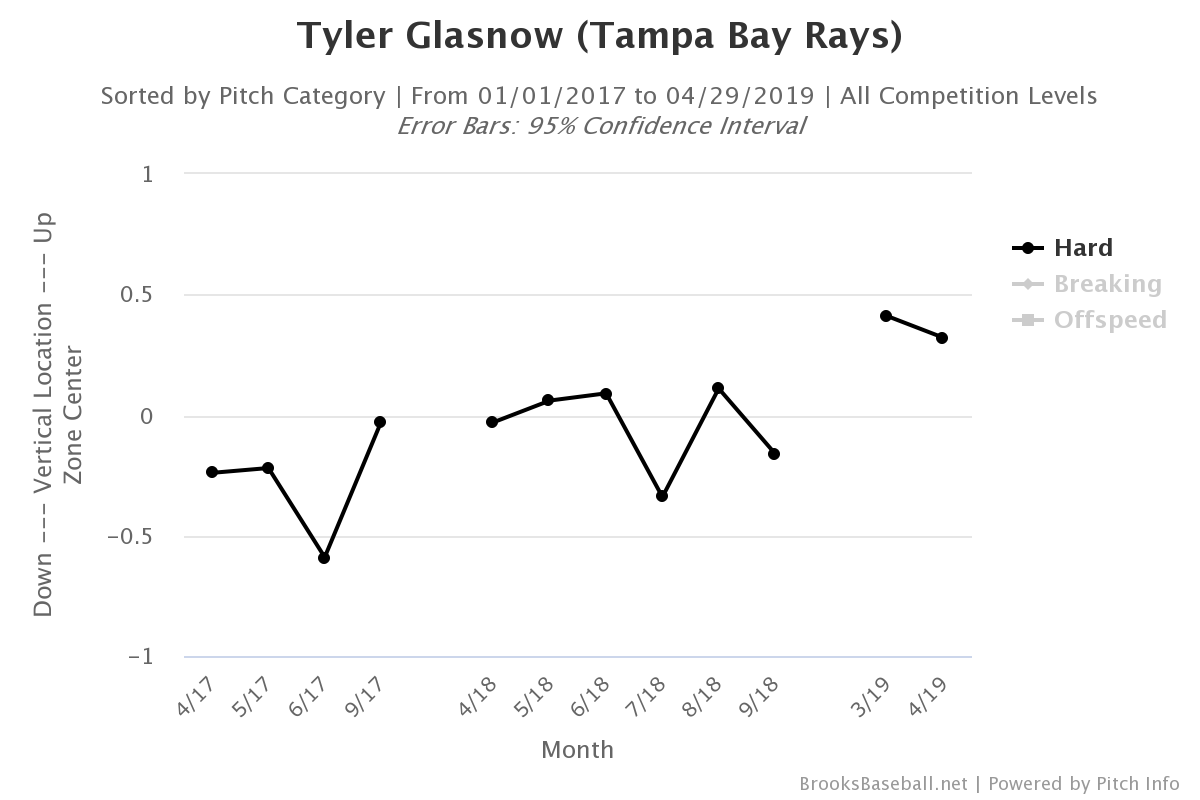
In 2017, Glasnow was pretty consistently down in the zone. Last year, he more or less was in the vertical center of the zone. This year, he’s really started to heighten it, and he’s been doing it all year. That’s the most important piece here. The other, which you can’t see, is that his curveball is creeping up and seeing the zone more than it has before as well.
Since last season, Glasnow has seen the seventh-greatest improvement in zone percentage, and tenth-best improvement in first-strike percentage. Compared to his career averages, his zone percentage has risen 7.4% for his fastball, and 8.2% for his curveball.
On multiple occasions, Glasnow has expressed that the Rays want him to throw his fastball up and curveball down. There are multiple reasons for this. For one, that’s where the whiffs come from.
Glasnow, whiffs on fastballs:
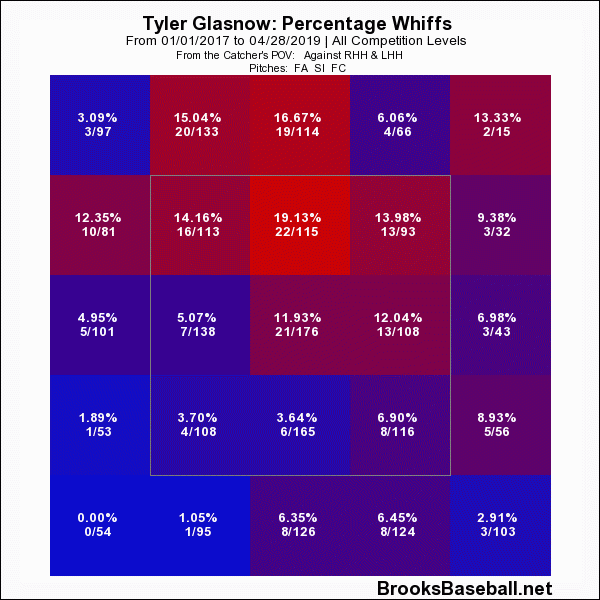
If you have the right fastball, it’s pretty safe to live up in the zone — and Glasnow has it. If he misses up, it’s not likely to get punished. It’s not an easy task to catch up to 96 mph up in the zone. Last year, Glasnow ranked 48th in wFB/C with 0.02, while this year he ranks third in wFB/C with a 2.37, so it appears to have paid dividends already.
It’s already hard to hit 96 mph up in the zone, but what if I told you it looks like Glasnow is throwing 99?
A scatter plot, with perceived velocity on the x-axis and extension on the y-axis:
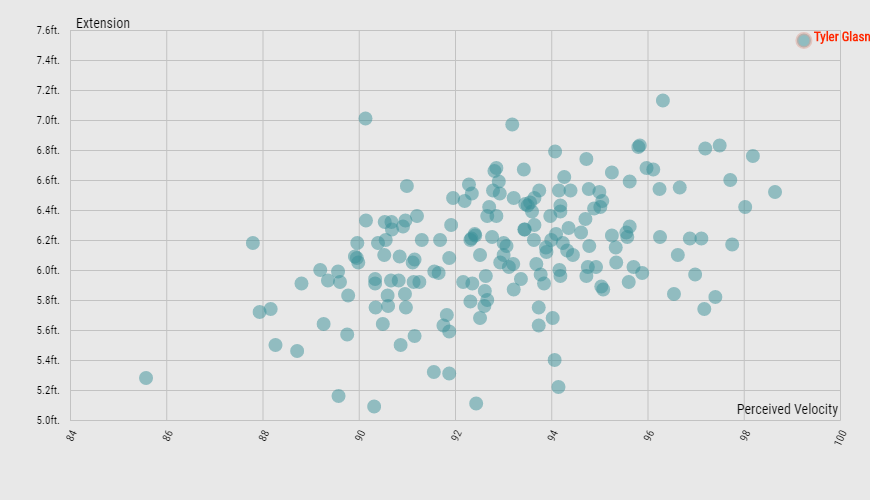
See that red dot at the top right? That’s Glasnow. It’s not like this is anything that hasn’t been written about before, but Glasnow, in this graphic, has the greatest extension by far, and he also has the highest perceived velocity. The two are related, as Glasnow is getting more than an extra foot of extension than most of his peers. As a result, his 96 mph heater plays up.
So one part is, his particular fastball is best suited to be pitched somewhere up in the zone. The other is it sets this up:
The pitch before, Jackie Bradley Jr. fouled off a fastball at the top of the zone. The next pitch he took a curveball in the middle of the zone for strike three. That’s what setting up with the high fastball can do for you, and that’s why Glasnow has benefited so greatly from throwing in the zone more. Turns out, he doesn’t need to bounce curveballs on the plate. That’s not to say that he won’t (because he will), but if he’s sequencing his pitches well, he can toss them in the zone liberally.
One reason he can do so is that hitters aren’t doing anything with them. In 2018, Glasnow’s groundball percentage on his curveball was 54%, good for 43rd of pitchers with 100 pitches. This year, Glasnow has increased his curveball’s groundball percentage significantly to 71%, which makes it the most groundball-heavy curveball in 2019.
Here’s Glasnow’s curveball:
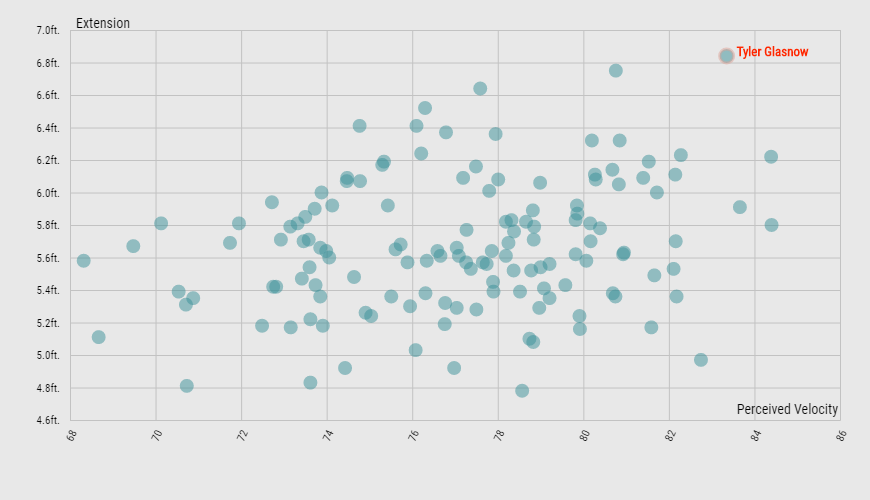
If you’ve never seen Glasnow’s curveball before, then this scatter plot may not mean a lot. Extension, regardless of pitch, is a good thing. Velocity is good, but it depends entirely on the pitch. With that said, not everyone has Glasnow’s curveball.
If you’d take a look at this curveball leaderboard, you will notice that Glasnow gets the fourth-most vertical movement on his curveball. Pitchers, at best, have his velocity or his vertical movement. Not both. Glasnow gets the best of both worlds, and his curveball spin rate is in the 92nd percentile to boot. Last year, Glasnow didn’t exactly have this curveball. It had more or less the same velocity, but it didn’t have the drop that it does this year. That’s fine! It’s a lot to ask to have elite movement and velocity — but now he has both.
Glasnow is 6’8″. When it comes to getting extension towards the plate, his height in a plus. But because he’s so tall, it’s easier for his delivery to get out of whack. This year, something must be clicking, because he’s gotten more consistent.
Glasnow’s horizontal release point, by game:
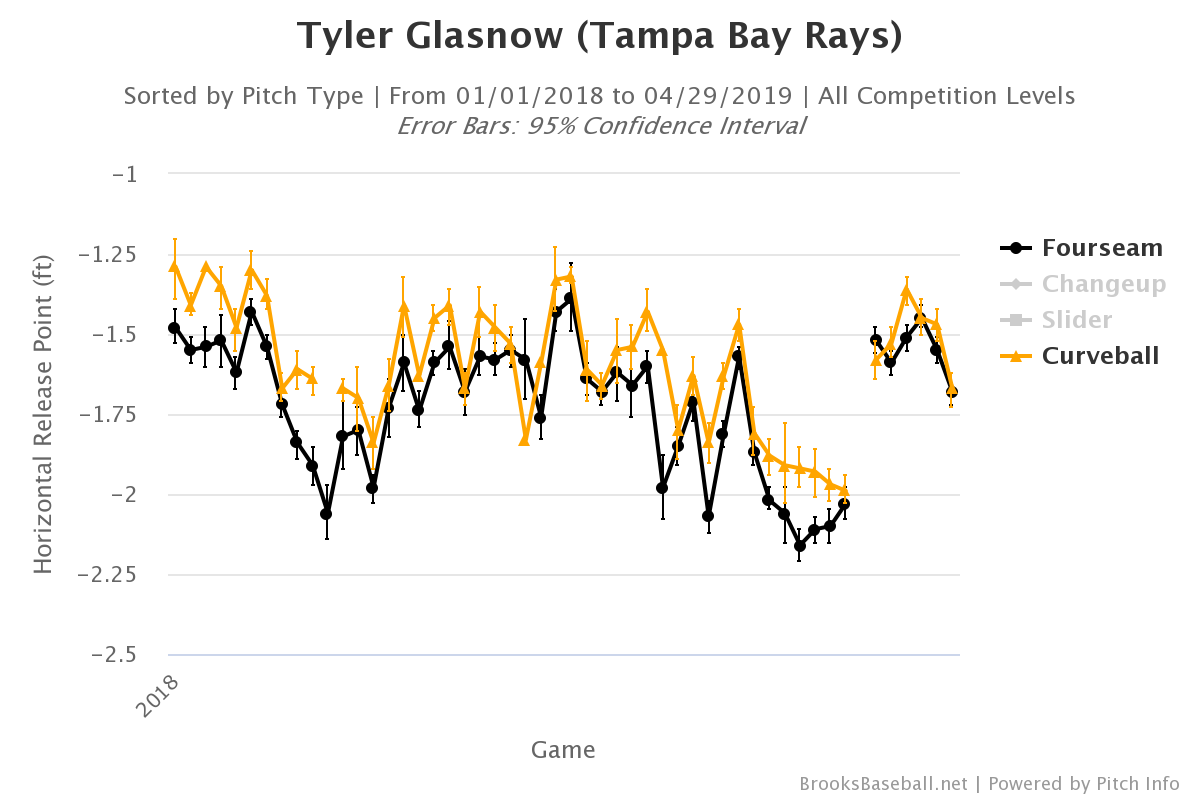
Glasnow’s vertical release point, by game:
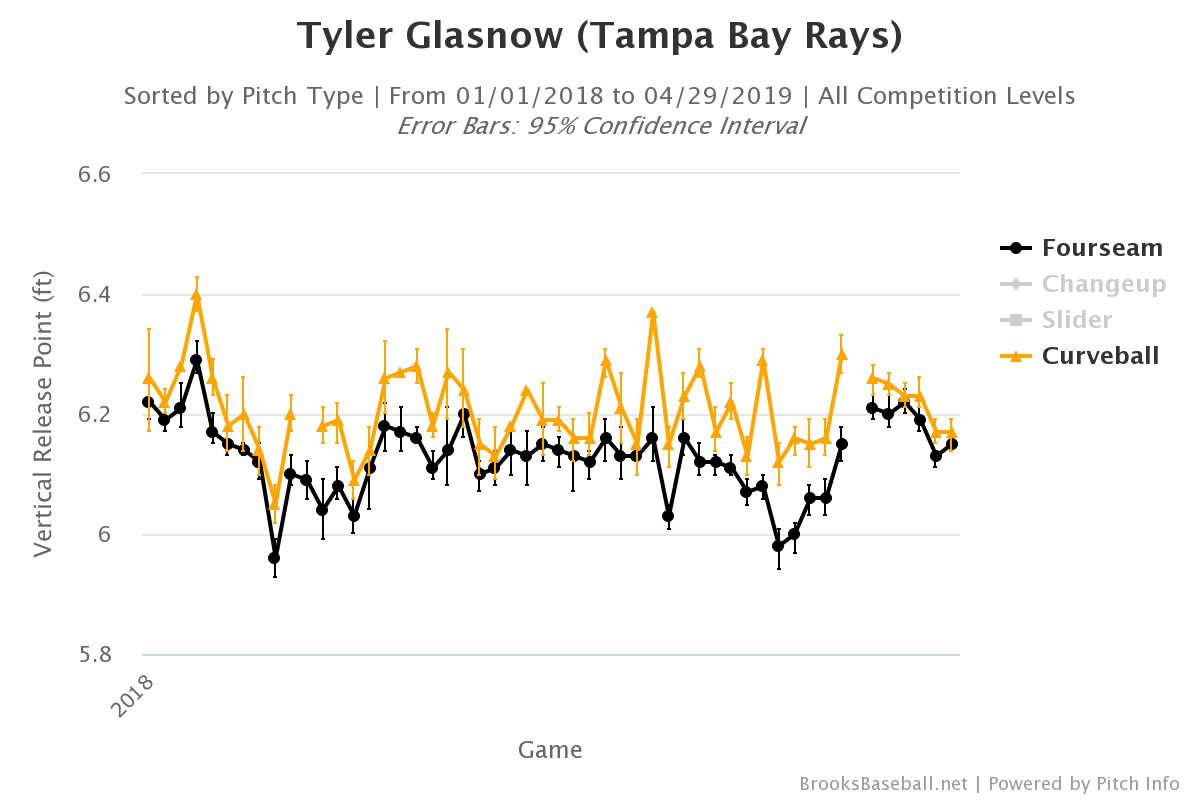
To me, the key is that Glasnow has improved the consistency in the release point of his fastball. The release points of both pitches are pretty different than last year, but what’s important is that when they change, they’re changing together. That’s caused his release points to overlap more overall:
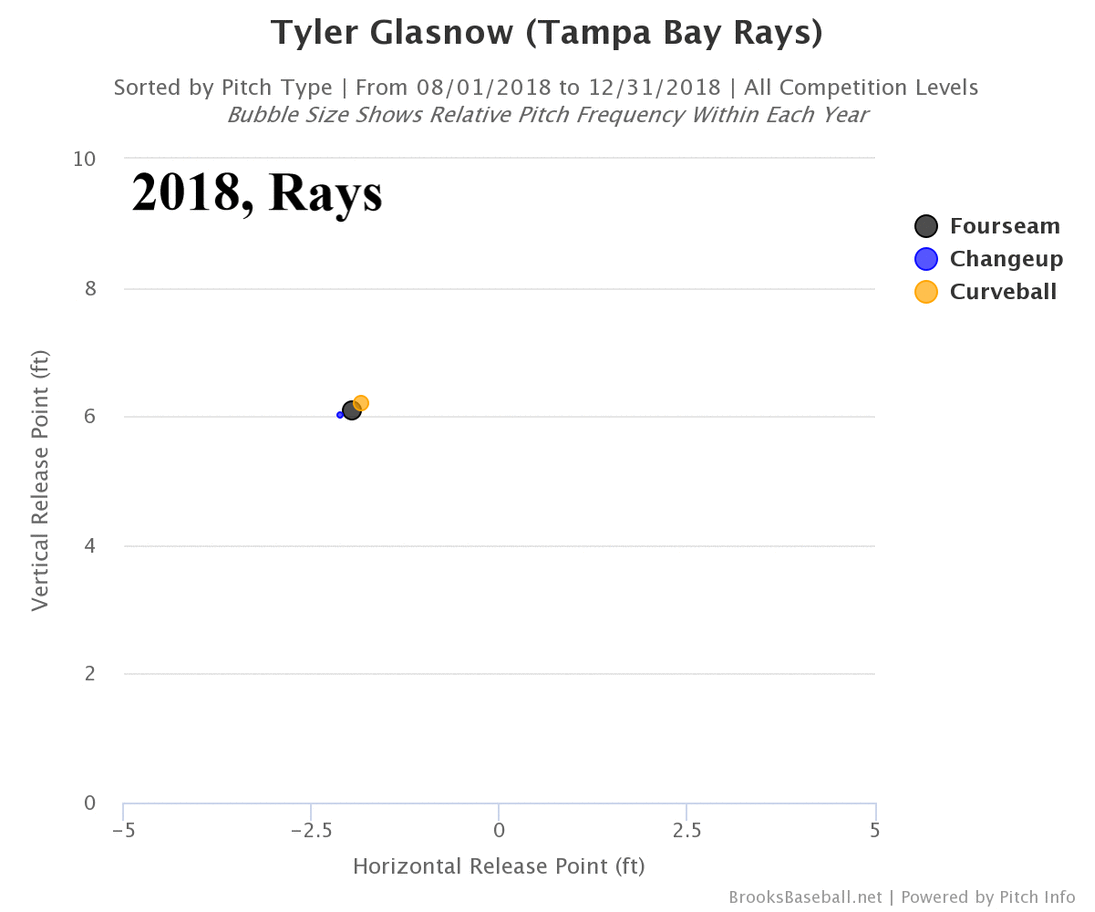
Earlier, I talked about how Glasnow’s curveball has gotten more vertical depth, and a touch less horizontal movement — this is why. The more over-the-top Glasnow is, the less sweepy he’ll be, and that’s where he wants to be. He’s brought in his horizontal release point in on his curveball, and thus changed his arm angle, and now he’s seeing pretty extreme 12-6 movement while retaining his velocity.
So with elevated fastballs, mid-to-low curveballs, and tightened up release points, I’ve set us up to talk about the obvious: pitch tunneling.
Glasnow versus Mookie Betts, 2018:
Glasnow starts off the at-bat with a fastball down the middle, which Betts takes for a strike. That eventually sets up his curveball, which he spikes into the ground for a ball. This overlay does a good job of showing what his 2018 looked like as a whole — especially his time with the Pirates. Not so many elevated fastballs and a lot of wasted breaking pitches below the zone.
Glasnow versus Betts, 2019:
Here is where Glasnow shines. The fastball up looks like a miss more than anything, but it backs Betts off of the plate, and it certainly isn’t the most hittable pitch ever. That’s the point, though: Glasnow has started to optimize the locations of his fastball and curveball. When he misses, which he will, hitters will either (a) be backed off of the plate, like Betts, or (b) see a pitch that looks like 99 mph up in the zone. The hope is that the new and improved Glasnow will follow that pitch up with something in the zone, or at the very least a pitch low out of the zone that tunnels well with his fastball — because he’ll still bounce a curveball or slider on occasion.
I haven’t touched on Glasnow’s other offerings, because he hardly throws them. I expect him to start moving towards his slider and changeup slightly more throughout the year, but for now, they make up just 8.4% of his pitches thrown. Last year, after two starts with the Rays, Glasnow started featuring a changeup as one of his offerings. He didn’t use it much, probably because he didn’t trust it much, but something interesting happened on Sunday.
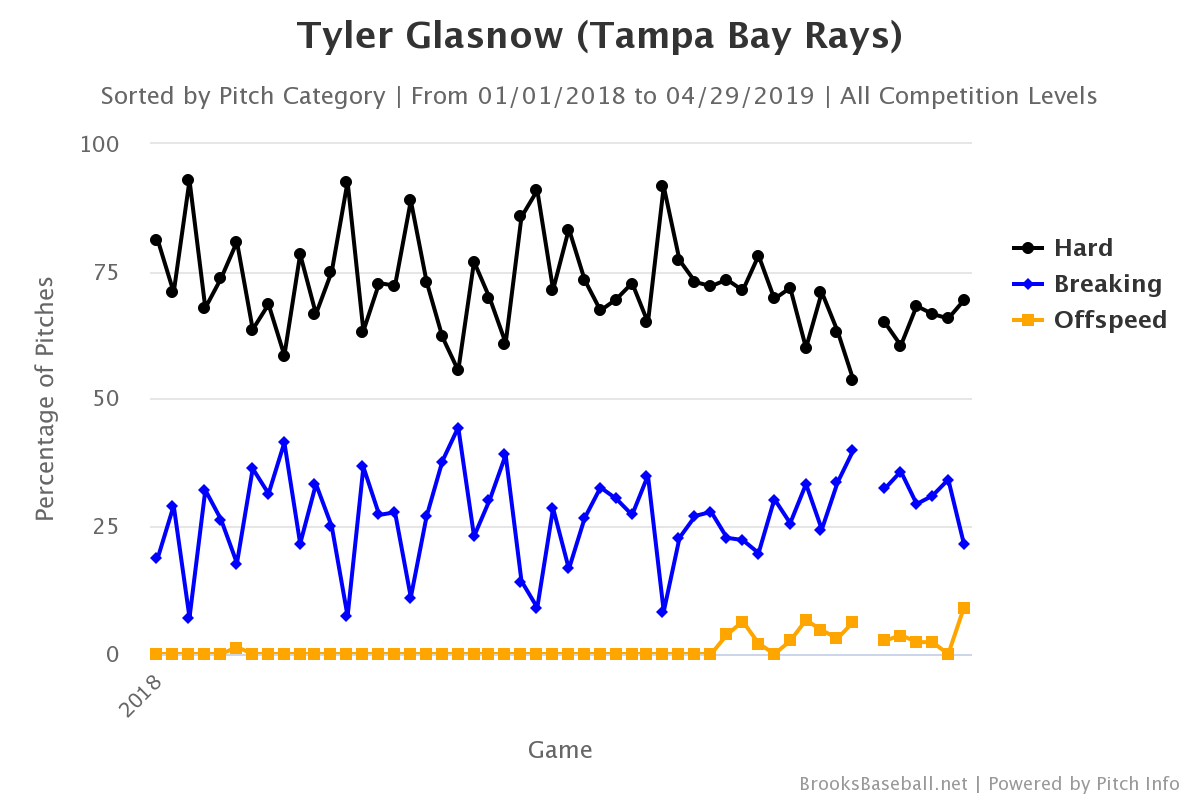
Glasnow has mostly been a fastball-curveball pitcher, but on Sunday, he featured his changeup more than he ever has. It wasn’t a ton — he threw nine total — but it’s easily the most he has thrown both this and last year. What’s intriguing is he didn’t go with a more diverse pitch mix, he just swapped out a few (okay, nine) curveballs in favor of changeups. Glasnow has talked about his changeup specifically:
After the throwing demonstration in Toronto, I had to double back to check in on the change, and when I asked about the off-speed pitch, Glasnow lit up again.
“It’s coming along,” Glasnow laughed, comfortable with the oddities of his towering size and massive hands in comparison to his peers.
Judging from Glasnow’s own words, we can presume that he’s becoming more comfortable in his changeup. From his actions (i.e. increasing changeup usage), we can deduct the same thing.
His changeup is basically a two-seam fastball, but given the separation in velocity to his fastball, it acts as a changeup. As Glasnow said himself, it’s coming along, but it’s not yet there. He’ll use it sometimes more than others, but we’re not quite to the point where he can feature it consistently, even against lefties. This may be an avenue to dominating lefties, so it will be interesting to watch it unfold as the season progresses.
A pitch overlay, from Sunday:
This is, more or less, the same as the 2019 overlay against Betts above. The difference here is that, with his changeup, Glasnow now has yet another pitch to show lefties. The issue is that his changeup is coming out of a different arm slot than his other pitches. From the release point graphic earlier, you can see that his fastball release point moved towards his curveball, which is good , but his changeup has more or less remained in the same arm slot as 2018. As a result, his changeup will fail to resemble anything like a perfect tunnel until with his other pitches for the time being. This is likely why Glasnow has shied away from going to it with more frequency. He’ll always rely mostly on his fastball and curveball, but the more doubt in hitters’ minds, the better.
Glasnow didn’t throw strikes, and now he does. Not only does he do it significantly more than he used to, he does it more than most pitchers. Glasnow has started to flash his changeup, and he’s got the slider in his back pocket. We’ve seen he can be effective as a fastball-curveball power pitcher, but maybe he’ll start to diversify his repertoire a smidge.
For a little, Glasnow looked like he might end up in the bullpen, but now he looks more like a dominant starter. The Rays deserve a lot of credit for helping him realize his potential and allowing him to pitch how he probably should have been all along. But also, Glasnow deserves most of it, since it’s likely he’s been this guy for a while now, aside from a few tweaks. Finally, Tyler Glasnow looks like the pitcher we all envisioned him to be. He’ll come back to earth at some point, but that’s not to say that there isn’t still room for improvement.
Featured image by Justin Paradis (@FreshMeatComm on Twitter)
(All GIFs courtesy of @AugustineMLB and Donny Moskovits)


Not the most important point, but JD Martinez was not actually in the lineup on Sunday.
I will openly question the statement that Glasnow has magically benefited from moving to TB. This was arguable the best pitching prospect in the game for several years – its not like he just changed when he was traded. His development path has been pretty predictable – it was always going to be harness the command or fade away. You state that the benefit is obvious a few times but as you point out in the year-over-year its not. Glasnow deserves credit for his off-season progression – not the team that pays his minimal salary IMO. For those that have followed him as a prospect, he is the same guy he always was. Tall pitcher always have taken longer to harness their command. I remember times when NYM, PIT and STL were getting the credit for being magicians, but as history always shows – they didn’t uncover any secrets otherwise they would be able to sustain it. The credit and blame should always be given to the players for their performances. To me it is a shame that we are talking about TB at all and not Glasnow the entire time.
Thanks for your comment!
Right, I don’t think he’s “magically” benefited from moving. That’s why I said, “The Rays deserve a lot of credit for helping him realize his potential and allowing him to pitch how he probably should have been all along. But also, Glasnow deserves most of it, since it’s likely he’s been this guy for a while now, aside from a few tweaks.”
Again, I don’t think he’s necessarily harnessed his command so much as picking a spot in the zone and throwing to it. Glasnow himself knows he’s a power pitcher first. If you’d read his interviews dating back to the trade last season, you’d know that he speaks very highly of TB’s pitching coach and that he’s had a lot to do with his success. But, again, as I’ve stated in the article, the skills were always there for Glasnow. They were just underutilized in PIT.
Randy Johnson, Roy Halladay, Tyler Glasnow. All three are huge. All three struggled with control early. It remains to be seen if Glasnow can find Johnson’s and Halladay’s consistency later on.
I actually looked at their BB/9 and it’s remarkable how similar these graphs are (Johnson got started at a later age and it seems like it took him one more year if this is truly Glasnow’s breakout). God help us Pirates fans if he continues on that trajectory.
https://www.fangraphs.com/comparison.aspx?playerid=1303&position=P&page=2&players=60,14374
Very interesting! Thanks for your comment. Looks like Glasnow follows Halladay’s trajectory for FIP as well.
The Metamorphosis of Tyler Glasnow….cause that title…was painful.
Thanks for the click!
How much innings cap do you expect for him this season?
I don’t see him the Rays pushing him past ~175 IP. He didn’t pitch many innings last season, but he was also mostly in the bullpen. With the Rays’ opener, I don’t expect it to be an issue. He probably won’t pitch enough innings for it to come up, though.